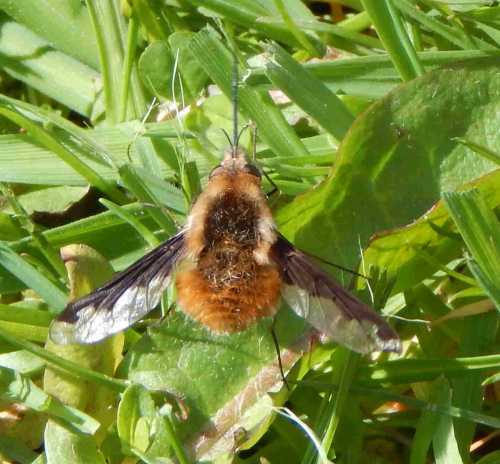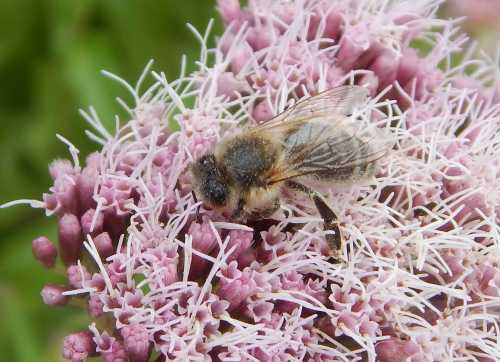The Different Types of Bees -
And Their Differences!
What are the differences between the different types of bees? What is the difference between bumblebees and honey bees, or solitary bees and bumblebees?
Of course, there are thousands of species of bees across the world – most of them being solitary bee species, and I cannot cover every species on this site.
However, let’s take a look at some of the general differences between honey bees, bumblebees and solitary bees with regard to
behavioural and life cycle habits.
Comparison Of The Life And Behaviours In Different Types Of Bees
Here are a few examples, with general comments. There may be exceptions and other differences, and they are not covered here.
Colonies
Honey bees: Honey bees live in large, well organised colonies or ‘societies’ of around 50,000 to 60,000 workers.
Bumble bees:
Bumble bees live in much smaller colonies, generally with around 120
workers, but sometimes as small as 40 workers, or very occasionally as
many as 400 in a rare, but very successful colony.
In tropical climates, some bumble bee species may produce much larger colonies.
Solitary bees: Solitary bees are of course, solitary, although
some species do live in a form of society, with sister bees nesting
close to each other. Species of mining bees can often be seen nesting in aggregations, with lots of tunnels or burrows from different bees occupying a patch of bare ground or lawn.
Nests
Honey bees:
In the wild, honey bees make their nests in the cavities of trees or
buildings. However, man has domesticated the honey bee, so that they
may be kept in hives.
Bumble bees: I have often been asked
if bumble bees live in hives. Of course, hives are man-made constructs
for keeping honey bees which live in large colonies. Depending on the
species of bumble bee, some may nest in abandoned rodent holes, whilst
others will choose tussocks of grass. However, with declining habitat
availability, they are becoming increasingly adaptable, and have been
found to nest in abandoned bird boxes and I have even heard of a bumble bee nest in an old jacket pocket!
See my page about
bumble bee nests.
Solitary bees: again, depending on the species, they may construct small nests in the ground, in cavities in wood or hollow stems - or even snail shells.
Honey
Honey bees: Honey bees make a large quantity of honey (possible due to the size of colonies – that is, many worker bees collecting nectar). Honey consists of nectar combined with a ‘bee enzyme’ that goes through a process of concentration in the honeycomb before it is capped by the bees. Learn more on my page 'How do bees make honey?'.
(Note: Meliponina - a type of bee closely related to the honey bee, and commonly called 'Stingless bee' also make a small amount of honey).
Bumble bees: Bumble bees, in one sense, make a form of
honey, which they collect in nectar pots to be eaten by the colony,
including the newly hatched worker females. However, the process of
concentrating, capping, and the making of honey combs does not happen in
bumble bee colonies, nor is nectar stored over winter, since only the
queen survives and hibernates, whilst the rest of the colony do not. Really, what bumble bees have is temporary nectar stores. You can read more about this subject on this page: Do bumble bees make honey?
Solitary bees:
Solitary bees do not make honey combs. They construct egg cells which
they provision with a ball of nectar and pollen that will be consumed by
the new larvae.
Queens
Honey bees: honey bee queens may naturally live for 2 to 3 years, but even as many as 4 years.
During her life, the queen honey bee lays thousands of eggs.
Bumble bees: Bumble bee queens have much shorter life cycles.
Some bumble bees emerge earlier or later than others, but a new queen
bumble bee emerging in the late summer will mate, hibernate, and remerge
the following year to establish a new colony. By the time she herself
produces new queens, it may then be the late summer again, whereupon she
and the rest of the colony will not usually survive (although patterns
can vary in different countries). Thus, if successful, a bumble bee
queen could live for up to one year. During this time, depending on the
species, she may produce a colony of 40 -120 workers. A very large
and less common, could have as many as 400 workers.
Solitary bees:
Solitary bees have adult females – I have never heard these females
referred to as ‘queens’ as such. All females emerging from egg cells
have the capability to mate and produce both males and females (in
contrast with worker female bumble bees, for example, which can only
produce male bumble bees, and cannot determine whether females will be
become queens or not). The number of eggs produced by the adult female
varies according to the type of solitary bee species, some may build a
series of nests, each containing 4 – 10 eggs. Others may lay fewer or
more, but in any case, they do not produce large numbers of workers as
honey bees do.
Swarming
You may well have seen swarming bees and it is well known that honey bees engage in this behaviour. I often get asked about bumble bee swarms. However, whereas honey bees do swarm, bumble bees do not (although you may see a small 'drone cloud' or gathering of males in some species, such as Bombus hypnorum - and perhaps this might be described as a 'bumblebee version' of swarming). Of course solitary bees are solitary, so they do not swarm, although again, you may see groups (or 'aggregations' of solitary bees buzzing around a nest site, since they will often makes nests in communal groups.
To find out more about this fascinating natural part of the
honey bee life cycle.
Lifespan
Removing
external factors such as predators or man's interference, the answer
is: 'It depends on the kind of bee, and the role within the colony'.
Rather than go into detail here, see may page entitled
'How long do bees live?'.
Life cycles
Not
surprisingly, if the life spans vary between the different types of
bees, then so do the life cycles. Again, rather than explain all here,
see my page about the
bee life cycle.
If you found this page helpful or interesting, I'd really be grateful if you would share it with others - if not this page, perhaps another, such as Gardening For Bees.
Thank you so much :) .

